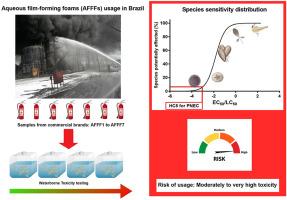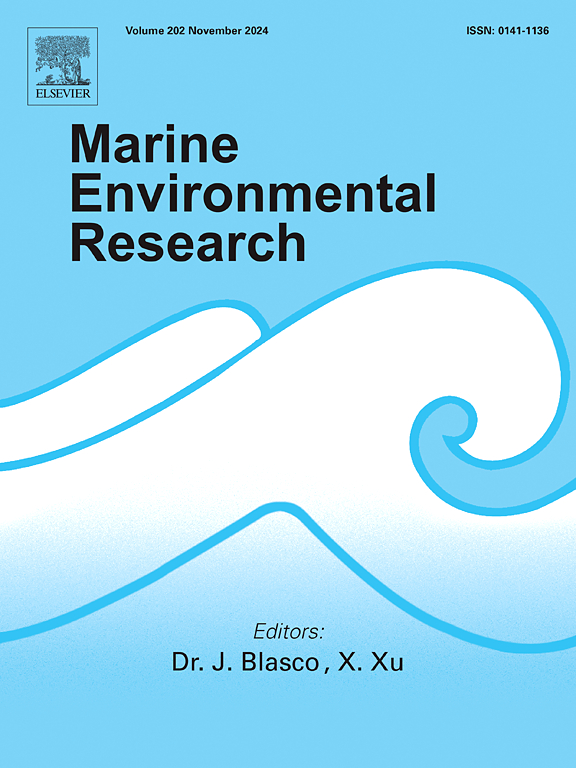巴西使用的水性成膜泡沫对新热带无脊椎动物有毒。
IF 3.2
3区 环境科学与生态学
Q2 ENVIRONMENTAL SCIENCES
引用次数: 0
摘要
水成膜泡沫(afff)在世界范围内是一种有效的灭火策略,其中许多产品由含有单氟烷基和多氟烷基物质(PFAS)的复杂混合物组成。基于pfas的afff的使用令人担忧,因为它们的一些成分被归类为持久性有机污染物,因此在工业和港口地区的消防中使用它们可能会增加对环境的影响。在本研究中,AFFFs对海洋无脊椎动物的毒性是通过水接触来评估的。在巴西桑托斯港(Port of Santos)的一场大火中,我们获得了7种基于pfas的商用afff (AFFF-1至AFFF-7),测试了它们对盐水虾(Artemia salina)的急性毒性和对褐贻贝(Perna Perna)、沙美元(sand dollar Mellita quinquiesperforata)、海胆(Lytechinus variegatus)和棘孔海胆(Echinometra lucunter)胚胎的慢性毒性。对其中两个样本进行了桡足动物Nitokra sp.繁殖的慢性毒性试验。所有afff对测试的海洋物种都有毒。据报道,有毒稀释度为0.0001 %至0.001 %,相当于浓度比制造商建议的施用量低1至1万倍。AFFF-1、AFFF-5、AFFF-7为中毒性,AFFF-3、AFFF-4、AFFF-5为剧毒,AFFF-2为剧毒。危险商值升高,比设定的阈值高100到1000倍。我们的研究结果为AFFF使用的环境危害提供了重要的见解,特别是在拉丁美洲和加勒比沿海生态系统,那里的监管框架仍在制定中。本文章由计算机程序翻译,如有差异,请以英文原文为准。

Aqueous film-forming foams used in Brazil are toxic to neotropical invertebrates
Aqueous film-forming foams (AFFFs) are an efficient firefighting strategy worldwide, and many of these products consist of complex mixtures containing per- and poly-fluoroalkyl substances (PFAS). The use of PFAS-based AFFFs is concerning because some of their constituents are classified as Persistent Organic Pollutants, thus their utilization during firefighting in industrial and harbor areas may increase the environmental impacts. In this study, the AFFFs toxicity to marine invertebrates was assessed using waterborne exposure. Seven PFAS-based commercial AFFFs (AFFF-1 to AFFF-7) employed to combat a major fire in the Port of Santos (Brazil) were obtained tested for acute toxicity to the brine shrimp Artemia salina and chronic toxicity to embryos of the brown mussel Perna perna, the sand dollar Mellita quinquiesperforata, and the sea urchins Lytechinus variegatus and Echinometra lucunter. Chronic toxicity tests on the reproduction of the copepod Nitokra sp. were conducted for two of the samples. All AFFFs were toxic to the marine species tested. Toxic dilutions were reported from 0.0001 % to 0.001 %, equivalent to concentrations between 1 and 10 thousand times lower than the application rates recommended by the manufacturers. AFFF-1, AFFF-5, and AFFF-7 were classified as moderately toxic, whereas AFFF-3, AFFF-4, and AFFF-5 were highly toxic, and AFFF-2 was very highly toxic. The hazard quotient values were elevated, ranging from 100 to 1000 times above the established thresholds. Our findings provide critical insights into the environmental hazards of AFFF use, particularly in Latin America and Caribbean coastal ecosystems, where regulatory frameworks are still being developed.
求助全文
通过发布文献求助,成功后即可免费获取论文全文。
去求助
来源期刊

Marine environmental research
环境科学-毒理学
CiteScore
5.90
自引率
3.00%
发文量
217
审稿时长
46 days
期刊介绍:
Marine Environmental Research publishes original research papers on chemical, physical, and biological interactions in the oceans and coastal waters. The journal serves as a forum for new information on biology, chemistry, and toxicology and syntheses that advance understanding of marine environmental processes.
Submission of multidisciplinary studies is encouraged. Studies that utilize experimental approaches to clarify the roles of anthropogenic and natural causes of changes in marine ecosystems are especially welcome, as are those studies that represent new developments of a theoretical or conceptual aspect of marine science. All papers published in this journal are reviewed by qualified peers prior to acceptance and publication. Examples of topics considered to be appropriate for the journal include, but are not limited to, the following:
– The extent, persistence, and consequences of change and the recovery from such change in natural marine systems
– The biochemical, physiological, and ecological consequences of contaminants to marine organisms and ecosystems
– The biogeochemistry of naturally occurring and anthropogenic substances
– Models that describe and predict the above processes
– Monitoring studies, to the extent that their results provide new information on functional processes
– Methodological papers describing improved quantitative techniques for the marine sciences.
 求助内容:
求助内容: 应助结果提醒方式:
应助结果提醒方式:


